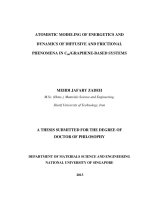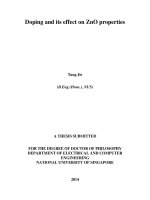Modeling of the tool edge radius effect on the mechanics of micromachining
Bạn đang xem bản rút gọn của tài liệu. Xem và tải ngay bản đầy đủ của tài liệu tại đây (13.25 MB, 267 trang )
MODELING OF THE TOOL EDGE RADIUS EFFECT ON
THE MECHANICS OF MICROMACHINING
WOON KENG SOON
NATIONAL UNIVERSITY OF SINGAPORE
2009
MODELING OF THE TOOL EDGE RADIUS EFFECT ON
THE MECHANICS OF MICROMACHINING
WOON KENG SOON
(B.Eng. Hons.)
A THESIS SUBMITTED
FOR THE DEGREE OF DOCTOR OF PHILOSOPHY
DEPARTMENT OF MECHANICAL ENGINEERING
NATIONAL UNIVERSITY OF SINGAPORE
2009
i
Acknowledgements
My PhD journey has never been easy. Despite the long and exhausting
working hours during term time, there was also constant mental stress during
semester breaks. It was undoubtedly difficult at the beginning. But as time goes by
the stress became less burdening, as it transformed from worries into a constant urge
of seeking for truths and answers.
I then realized the PhD journey is not just a
scientific quest, but also a training course to prepare oneself for a much greater
journey ahead - a lifelong self-learning, self-discovery and self-challenge expedition
of his or her own.
In this journey of mine, I wish to express my heartfelt gratitude to my teacher,
Professor Mustafizur Rahman for his unconditional support and guidance and for
being the source of inspiration. His remarkable influences on me will be timeless
and without boundaries.
For university staffs that helped in experiments and FE-analysis, I hope they
know how much I value their generosity. Specifically, KS Neo, CH Tan, Nelson
Yeo, SC Lim, YC Ho, CL Wong and Simon Tan of AML; Alvin Goh and Joe Low
of IML; and EH Yeo from SVU. My thanks are also due to Drs. F.Z. Fang, K. Liu,
J H. Ko and Narrisara of SIMTech for their valuable advice. Special thanks to my
colleagues for their help in different ways and more importantly for their friendships.
They are Subra, Masheed, Sharon, Angshuman, Indraneel, Pervej, Li Tao, Poh
Ching, Shaun, Rajenish, Lingling, Hesham, Haiyan, Liu Yuan, Liqing, Anwar,
Biddut, Ibrahim, Sonti, Chin Seong, Masahiro, Michael and Zhigang.
Moreover, I would like to thank my parents for their precious love and
encouragement that have kept me strong to face numerous challenges. I am also
deeply indebted to my elder sister and brother for their understanding of my long
absence from home throughout these years.
ii
Table of Contents
Acknowledgements
i
Table of Contents
ii
Summary
vi
List of Tables
viii
List of Figures
ix
List of Symbols
xviii
Chapter 1 Introduction
1
1.1 Background
1
1.2 Scope and Objectives
8
1.3 Thesis Outline
11
Chapter 2 The Review of Literature
14
2.1 Specific Cutting Force and Energy
14
2.2 Chip Formation Mechanism
17
2.3 Surface Finish
19
2.4 Minimum Undeformed Chip Thickness
23
2.5 Contact Phenomenon
25
2.6 Finite Element Method in Machining Simulation
28
2.7 Summary
31
Chapter 3 Finite Element Modeling: An Arbitrary Lagrangian-
Eulerian Method
33
3.1 Limitations of Pure Lagrangian and Eulerian Methods
33
3.2 The Advantages of Arbitrary Lagrangian-Eulerian Method
35
iii
3.3 Governing Equations
36
3.3.1 Description of Kinematics
38
3.3.2 Conservation Equations
41
3.4 Working Principles
42
3.4.1 Mesh Layout
42
3.4.2 Mesh Smoothing
43
3.4.3 Solutions Advection
44
3.5 Deformation Behavior
47
3.6 Contact Characteristics
48
3.7 Heat Generation and Conduction
49
3.8 Model Configuration and Boundary Conditions
50
Chapter 4 Experimental Verification
56
4.1 Technical Challenges
56
4.1.1 Mechanical Aspects
56
4.1.2 Optical Aspects
57
4.2 Machine Tool
58
4.3 Cutting Tools
58
4.4 Workpiece Material
60
4.6 Experimental Setup
61
4.7 Experimental Design
63
4.8 Model Validation
64
4.8.1 Tool-Chip Contact Length
65
4.8.2 Deformed Chip Thickness
67
4.8.3 Machining Force 69
iv
4.9 Summary
72
Chapter 5 Contact Phenomenon
74
5.1 Material Separation and Frictional Shear Contact
74
5.2 Contact Stress and Stick-Slide Regions
80
5.3 Stick-Slide Characteristics
85
5.4 Tool-Chip Contact Length: A Linear Regression Analysis
92
5.5 Tool Wear Phenomenon of Edge-Radiused Cutters
96
5.6 Summary
99
Chapter 6 Chip Formation Behavior
101
6.1 Transitional Chip Formation Behavior
101
6.2 Deformation Intensity of the Primary Deformation Zone
107
6.2.1 Width of PDZ
109
6.2.2 Thickness of PDZ
113
6.2.3 Depth of PDZ
117
6.3 Deformed Chip Thickness: A Linear Regression Analysis
122
6.4 Summary
127
Chapter 7 Tool Edge Radius Effect: A Non-Dimensional Analysis
129
7.1 Tool-Chip Contact Length
129
7.2 Deformed Chip Thickness
133
7.3 Machining Force
137
7.4 Summary
143
Chapter 8 Extrusion-like Chip Formation Mechanism: A Sensitivity
and Behavioral Study
145
v
8.1 A Mesh-Refined Arbitrary Lagrangian-Eulerian Model
145
8.2 Sensitivity Analysis: Nodal Displacement Vectors
147
8.2.1 Initial Chip Formation
148
8.2.2 Chip Growth 151
8.3 Behavioral Analysis: Stress Distributions
162
8.3.1 Principal Stress
164
8.3.2 Hydrostatic Pressure and Shear Stress
167
8.3.3 In-Plane Principal Stress
171
8.4 Discussions
179
8.4.1 The Stress Model
181
8.4.2 Shear Stress and Le-Chatelier’s Principle
183
8.4.3 The Role of Compressive Stress
185
8.4.4 Surface Roughness and Extrusion-like Mechanism
189
8.4.5 Summary
196
Chapter 9 Conclusions
198
9.1 Contact Phenomenon
199
9.2 Chip Formation Behavior
200
9.3 Tool Edge Radius Effect
200
9.4 Extrusion-like Chip Formation Mechanism 201
9.5 Future Work
202
Bibliography
205
Appendix
216
Publication List
242
vi
Summary
The mechanics of tool-based micromachining is significantly different from
that of conventional-macro machining due to the tool edge radius effect. Such effect
arises in micromachining as the micron-scale undeformed chip thickness approaches
the size of the tool edge radius of several microns. A predictive cutting model that
assumes a perfectly sharp cutting edge yields reasonable agreement with
experimental results in conventional-macro machining. But such an assumption is
not valid in micromachining under the governance of the tool edge radius effect.
This phenomenon is especially profound in metallic materials, but its operating
mechanism is not fully understood at present.
This thesis presents a fundamental modeling study of the tool edge radius
effect in tool-based micromachining. Through an advanced finite element modeling
technique based on the arbitrary Lagrangian-Eulerian method, such effect is
quantified as the relative tool sharpness a/r, the ratio of undeformed chip thickness a
to tool edge radius r. The analysis was performed concurrently on both tool-chip
tribology and plastic deformation, as the main physical phenomena in metal
machining.
Findings of this study have revealed that the flow stagnation phenomenon
during material separation could be driven by the counterbalance of frictional shear
contact components on the tool edge radius, with a constant stagnation point angle
under different machining conditions. A contact model for micromachining was
proposed following the identification of three distinctive sticking and sliding regions
along the tool edge radius. With this contact model, the tool wear phenomenon of
‘edge-radiused’ cutting tools was reasonably elucidated.
Furthermore through the decrease of a/r from the above to below unity,
transitions in chip formation behavior were encountered. Material deformation
became increasingly more localized ahead of the rounded tool edge due to the effect
of tool edge radius on the contact length, which resulted in an increase of
vii
deformation intensity. At a critical a/r threshold below unity, the chip formation
mechanism transformed from concentrated shear deformation to a thrust-oriented,
extrusion-like behavior alongside the formation of an effective negative rake angle.
The extrusion-like mechanism was found to operate under severe deviatoric stress
alongside intense compressive stress and hydrostatic pressure as governed by the Le-
Chatelier's Principle. Thus the formations of continuous chip through such a
mechanism would prevent micro-void nucleation in the primary deformation zone
and produces high quality surface finish comparable to that in surface grinding.
viii
List of Tables
Table 3.1 Machining conditions, tribological parameters, tool and
workpiece properties.
55
Table 4.1 Mechanical properties of the WC-Co cutting tool.
59
Table 4.2 Machining conditions for experimental verifications.
64
Table 5.1 Summary of the stick-slide characteristic in tool-based
micromachining.
87
Table 5.2 Linear relationships between contact length, L
c
and undeformed
chip thickness, a for tool edge radius of 10 µm, at different
cutting speeds and tool rake angles.
94
Table 5.3 Linear relationships between contact length, L
c
and undeformed
chip thickness, a for tool edge radius of 5 µm, at different
cutting speeds and tool rake angles.
94
Table 8.1 Surface roughness at different a/r and cutting speeds (r =10 μm;
γ
= +10° ).
194
ix
List of Figures
Figure 1.1 Hydrostatic stress distributions along the shear plane in
conventional machining of metallic materials. (after Roth and
Oxley, 1972)
9
Figure 2.1 (a) Indentation force, R
n
and resultant force, R
c
induced by
induced by tool radius and tool face respectively. (b)
Differences in power, F
P
and feed components, F
Q
with
undeformed chip thickness in cutting force. (after Masuko,
1953)
15
Figure 2.2 Exponential increment in total specific energy with fine
reductions in undeformed chip thickness. (after Lucca, 1991)
16
Figure 2.3 SEM micrographs of chip root region produced with a
spring-operated quick-stop device on Al2024-T3, a = 37 μm
and r = 38 μm. (after Subbiah and Melkote, 2008)
19
Figure 2.4 Influences of feedrates and tool edge radii effect on ferrous
materials. (after Volger et al., 2004)
20
Figure 2.5 Varying machined qualities on silicon wafers at different
combinations of undeformed chip thicknesses and tool edge
radii. (after Arefin et al., 2004)
22
Figure 2.6 Relationships between cutting forces and chip loads on
pearlite.
(after Liu et al., 2004)
25
Figure 3.1 Referential domain Rχ, material domain RX, and spatial
domain Rx in the ALE framework associated with reference
coordinates χ, material particles X, and spatial points x
respectively. The domains are connected through single
mapping φ, Ф and Ψ. (after Stein et al, 2004)
39
Figure 3.2 Computational mesh layout. (a) One-dimensional; and (b)
two-dimensional.
42
Figure 3.3 (a) Deformations of computational mesh during chip
formation (b) undeformed state; and (c) deformed state.
43
Figure 3.4 Illustration of the Half-Index Shift (HIS) method.
46
Figure 3.5 Illustration of the building elements and work flow of the
arbitrary Lagrangian-Eulerian finite element model for tool-
based micromachining.
51
x
Figure 3.6 Coupled temperature-displacement elements. (a) 4-node
element for the workpiece; and (b) 3-node element for the
cutting tool.
52
Figure 3.7 Configuration of computationally meshed tool-workpiece
entities with predefined boundary conditions in the ALE
domain. γ = +10°, 0°, -10°; α = 6° and r = 5 µm, 10 µm are
determined from actual WC-Co cutting tools used in the
experiment.
53
Figure 3.8 Mean friction coefficient, µ
mean
of tool-workpiece under dry
condition.
54
Figure 4.1 Ultraprecision machine tool for micromachining
experiments.
58
Figure 4.2 Tool geometries of the micro-grain WC-Co cutting tool. It is
made up of carbide grains with an average size of 0.7 μm.
59
Figure 4.3 Schematic diagram of the complete experimental setup which
includes the orthogonal machining configuration, the
imaging, optical and lighting systems.
61
Figure 4.4 High speed images of tool-based micromachining for
different magnitudes of undeformed chip thickness, a
attempted.
63
Figure 4.5 Illustration of the complete experimental setup for tool-based
micromachining of medium carbon steel with cemented
tungsten carbide cutters.
63
Figure 4.6 Distributions of contact length, Lc for varying undeformed
chip thickness, a from 2 µm to 20 µm (with an interval of 2
µm), at cutting speed, V of 100 m/min.
66
Figure 4.7 Distributions of contact length, Lc for varying undeformed
chip thickness, a from 2 µm to 20 µm (with an interval of 2
µm), at cutting speed, V of 250 m/min.
66
Figure 4.8 Distributions of contact length, Lc for varying undeformed
chip thickness, a from 2 µm to 20 µm (with an interval of 2
µm), at cutting speed, V of 500 m/min.
67
Figure 4.9 Distributions of deformed chip thickness, tc for varying
undeformed chip thickness, a from 2 µm to 20 µm (with an
interval of 2 µm), at cutting speed, V of 100 m/min.
68
xi
Figure 4.10 Distributions of deformed chip thickness, tc for varying
undeformed chip thickness, a from 2 µm to 20 µm (with an
interval of 2 µm), at cutting speed, V of 250 m/min.
68
Figure 4.11 Distributions of deformed chip thickness, tc for varying
undeformed chip thickness, a from 2 µm to 20 µm (with an
interval of 2 µm), at cutting speed, V of 500 m/min.
69
70 Figure 4.12 Distributions of cutting force, Fc and thrust force, Ft for
varying undeformed chip thickness, a from 2 µm to 20 µm
(with an interval of 2 µm), at cutting speed, V of 100 m/min.
Figure 4.13 Distributions of cutting force, Fc and thrust force, Ft for
varying undeformed chip thickness, a from 2 µm to 20 µm
(with an interval of 2 µm), at cutting speed, V of 250 m/min.
70
Figure 4.14 Distributions of cutting force, Fc and thrust force, Ft for
varying undeformed chip thickness, a from 2 µm to 20 µm
(with an interval of 2 µm), at cutting speed, V of 500 m/min.
71
Figure 5.1 Flow stagnation point on the rounded curvature of tool edge
radius, r. (a) r = 33 µm; and (b) r = 2 µm. Stagnation point
angle, δ
s
is approximately 60°. (after Jaspers and
Dautzenberg, 2002)
75
Figure 5.2 Spatial velocities on the stagnation point and flow retardation
zone are zero and close to zero respectively. For a = 2-20
µm, stagnation point angles, δ
s
= δ
sv
. Examples are shown for
(a) γ = +10°, a = 10 µm, V = 100 m/min; (b) γ = 0°, a = 14
µm, V = 250 m/min; and (c) γ = -10°, a = 18 µm, V = 500
m/min.
76
Figure 5.3 Spatial velocities on the stagnation point and flow retardation
zone are zero and close to zero respectively. For a = 2-20
µm, stagnation point angles, δ
s
= δ
sv
. Examples are shown for
(a) γ = +10°, a = 10 µm, V = 100 m/min; (b) γ = 0°, a = 14
µm, V = 250 m/min; and (c) γ = -10°, a = 18 µm, V = 500
m/min.
78
Figure 5.4 Constant stagnation point angle, δ
sf
= δ
s
= 58.5°±0.5° for
undeformed chip thickness, a = (a) 20 µm; (b) 18 µm; (c) 16
µm; (d) 14 µm; (e) 12 µm; (f) 10 µm; (g) 8 µm; (h) 6 µm; (i)
4 µm; and (j) 2 µm at tool rake angle, γ
= +10°.
79
Figure 5.5 Constant stagnation point angle, δ
sf
= δ
s
= 58.5°±0.5° for
undeformed chip thickness, a = (a) 20 µm; (b) 18 µm; (c) 16
µm; (d) 14 µm; (e) 12 µm; (f) 10 µm; (g) 8 µm; (h) 6 µm; (i)
4 µm; and (j) 2 µm at tool rake angle, γ
= 0°.
79
xii
Figure 5.6 Constant stagnation point angle, δ
sf
= δ
s
= 58.5°±0.5° for
undeformed chip thickness, a = (a) 20 µm; (b) 18 µm; (c) 16
µm; (d) 14 µm; (e) 12 µm; (f) 10 µm; (g) 8 µm; (h) 6 µm; (i)
4 µm; and (j) 2 µm at tool rake angle, γ
= -10°.
80
Figure 5.7 Stick-slide interactions on 3 different regions over the tool-
chip and tool-work contact interfaces at different time steps, t
= (a) 30 µs; (b) 40 µs; and (c) 50 µs. Sticking is mainly
concentrated on the rounded tool edge while sliding happens
above and below the sticking region on the rake and
clearance faces. (Example is shown for γ
= +10°, a = 8 µm, V
= 100 m/min)
81
Figure 5.8
Distributions of (a) Sticking Region (b-x), Sliding Region I
(b-d) and Sliding Region II (x-z) on the cutting tool and; (b)
Corresponding frictional shear contact stress on (b-x), (b-d)
and (x-z). Stagnation Region (a-w) is contained within the
Sticking Region with the Stagnation Point (o) as the centre of
the regions while both Sliding Regions I and II are consisted
of primary and secondary regions
83
Figure 5.9 Impositions of high normal pressure perceived as indenting
actions by the rounded curvature of tool edge radius. (a) r
=
10 µm, γ
= +10°; (b) r
= 10 µm, γ
= 0°; (c) r
= 10 µm, γ
= -
10°; (d) r
= 5 µm, γ
= +10°; (e) r
= 5 µm, γ
= 10°; and (f) r
= 5
µm, γ
= +10°. Note that a larger tool edge radius imposes
greater density of normal pressure than that of a smaller tool
edge radius.
84
Figure 5.10 Development of tool-chip contact length, L
c
in two distinct
stages, Stage-I and Stage-II associated with the stick-slide
characteristics: (1) Sliding-I; (2) Sticking and; (3) Sliding-II.
86
Figure 5.11 Examples of time-history plot of contact length evolutions
for tool edge radius, r of 5 µm at cutting speed, V of 100
m/min: (a) γ = +10°; (b) γ = 0° and; (c) γ = -10°.
89
Figure 5.12 Examples of time-history plot of contact length evolutions
for tool edge radius, r of 10 µm at cutting speed, V of 100
m/min: (a) γ = +10°; (b) γ = 0° and; (c) γ = -10°.
90
Figure 5.13 Variations in the vector of normal contact pressure, σ
n
on tool
rake of different rake angles. (a) Negative rake angle, γ = -
10°; and (a) Positive rake angle, γ = +10°.
91
Figure 5.14 Linear evolutions of contact length with undeformed chip
thickness for tool edge radius of 10 µm.
93
xiii
Figure 5.15 Linear evolutions of contact length with undeformed chip
thickness for tool edge radius of 5 µm.
93
Figure 5.16 Crater and flank wear on an ‘edge-radiused’ cemented
carbide cutting tool. (after Kountanya and Endres, 2004)
97
Figure 5.17 Relationships between the tool wear phenomenon of ‘edge-
radiused’ tools and the contact phenomenon in tool-based
micromachining. (a) Experimental findings of Kountanya
and Endres (2004); and (b) Contact model for tool-based
micromachining as proposed in Section 5.2.
98
Figure 6.1 Transitions in plastic deformation behavior with decreasing
a/r, using different tool rake angles, γ
tool
of +10°, 0° and -10°
at the cutting speed, V of 100 m/min: (a-b) a/r > 1.0; (c) a/r
= 1.0; (d-e) a/r < 1.0.
103
Figure 6.2 Transitions in plastic deformation behavior with decreasing
a/r, using different tool rake angles, γ
tool
of +10°, 0° and -10°
at the cutting speed, V of 250 m/min: (a-b) a/r > 1.0; (c) a/r
= 1.0; (d-e) a/r < 1.0.
103
Figure 6.3 Transitions in plastic deformation behavior with decreasing
a/r, using different tool rake angles, γ
tool
of +10°, 0° and -10°
at the cutting speed, V of 500 m/min: (a-b) a/r > 1.0; (c) a/r
= 1.0; (d-e) a/r < 1.0.
104
Figure 6.4 Contour plots of von Mises stress distributions during the
transitional formations of effective rake angles, γ
eff
at
decreasing a/r. (a) Effective positive rake angle, +γ
eff
at a/r =
0.4; and (b) Effective negative rake angle, -γ
eff
at a/r = 0.2. A
nominal tool rake angle γ
tool
of +10° is used in both (a) and
(b).
106
Figure 6.5 Highly localized von Mises stress distributions and thus
plastic deformation ahead of the tool edge radius with the
formation of effective negative rake angles, -γ
eff
. Such
phenomenon is encountered for different combinations of
machining conditions at a/r = 0.2. (a-b-c) represents V of
500 m/min, 250 m/min, 100 m/min and (1-2-3) denotes γ
tool
of +10°, 0°, -10°.
107
Figure 6.6 Characterization of the primary deformation zone (PDZ)
from its width, thickness and depth.
109
Figure 6.7
Linear evolutions of WPDZ with undeformed chip thickness
using different tool rake angles and tool edge radius, at the
110
xiv
cutting speed, V of 100 m/min.
Figure 6.8
Linear evolutions of WPDZ with undeformed chip thickness
using different tool rake angles and tool edge radius, at the
cutting speed, V of 250 m/min.
111
Figure 6.9
Linear evolutions of WPDZ with undeformed chip thickness
using different tool rake angles and tool edge radius, at the
cutting speed, V of 500 m/min.
111
Figure 6.10
Linear evolutions of TPDZ with undeformed chip thickness
using different tool rake angles and tool edge radius, at the
cutting speed, V of 100 m/min.
114
Figure 6.11
Linear evolutions of TPDZ with undeformed chip thickness
using different tool rake angles and tool edge radius, at the
cutting speed, V of 250 m/min.
115
Figure 6.12
Linear evolutions of TPDZ with undeformed chip thickness
using different tool rake angles and tool edge radius, at the
cutting speed, V of 500 m/min.
115
Figure 6.13
Linear evolutions of DPDZ with undeformed chip thickness
using different tool rake angles and tool edge radius, at the
cutting speed, V of 100 m/min.
118
Figure 6.14
Linear evolutions of DPDZ with undeformed chip thickness
using different tool rake angles and tool edge radius, at the
cutting speed, V of 250 m/min.
119
Figure 6.15
Linear evolutions of DPDZ with undeformed chip thickness
using different tool rake angles and tool edge radius, at the
cutting speed, V of 500 m/min.
119
Figure 6.16 Illustration of the deformed chip thickness t
c
, as a collective
indicator of plastic deformation induced during chip
formation.
122
Figure 6.17 Linear evolutions of deformed chip thickness with
undeformed chip thickness for tool edge radius of 10 µm.
124
Figure 6.18 Linear evolutions of deformed chip thickness with
undeformed chip thickness for tool edge radius of 5 µm.
124
Figure 7.1 The response of normalized contact length, Lc/a to the ratio
of undeformed chip thickness to tool edge radius, a/r at
different tool rake angles, γ and cutting speeds, V for r of 10
µm.
130
xv
Figure 7.2 The response of normalized contact length, Lc/a to the ratio
of undeformed chip thickness to tool edge radius, a/r at
different tool rake angles, γ and cutting speeds, V for r of 5
µm.
132
Figure 7.3 Evolutions of normalized undeformed chip thickness, tc/a to
the ratio of undeformed chip thickness to tool edge radius,
a/r at different tool rake angles, γ and cutting speeds, V for r
of 10 µm.
134
Figure 7.4 Evolutions of normalized undeformed chip thickness, tc/a to
the ratio of undeformed chip thickness to tool edge radius,
a/r at different tool rake angles, γ and cutting speeds, V for r
of 5 µm.
136
Figure 7.5 Evolutions of normalized machining force, Ft/Fc to the ratio
of undeformed chip thickness to tool edge radius, a/r at
different tool rake angles, γ and cutting speeds, V for r of 5
µm.
140
Figure 7.6 Evolutions of normalized machining force, Ft/Fc to the ratio
of undeformed chip thickness to tool edge radius, a/r at
different tool rake angles, γ and cutting speeds, V for r of 10
µm.
143
Figure 8.1 Configuration of mesh-refined computational tool-workpiece
entities with predefined boundary conditions in the ALE
domain for the behavioral and sensitivity study of extrusion-
like chip formation mechanism. γ = +10°, α = 6° and r = 10
µm.
147
Figure 8.2 Nodal displacement plot of initial chip formation at a/r ≥
0.275.
148
Figure 8.3 Evolution of nodal displacement vectors during initial chip
formation at a/r ≥ 0.275.
149
Figure 8.4 Unique nodal displacement plot of the extrusion-like chip
formation mechanism in the preliminary stage at a/r ≤ 0.250.
150
Figure 8.5 Nodal displacements evolution of the extrusion-like
mechanism during initial chip formation at a/r ≤ 0.250.
151
Figure 8.6 Illustration of the formations of effective positive rake angles
for CAT-I chip formation mechanism at a/r of 0.8, 0.6, and
0.4.
152
xvi
Figure 8.7 Evolutions of nodal displacement vectors in the PDZ for
CAT-I chip formation mechanism with +γ
eff
.
154
Figure 8.8 Illustration of the formations of effective negative rake
angles for
155
CAT-I chip formation mechanism at a/r of 0.300 and 0.275.
Figure 8.9 Evolutions of nodal displacement vectors in the PDZ for
CAT-I chip formation mechanism with -γ
eff
.
157
Figure 8.10 Illustration of the formations of effective negative rake
angles for CAT-II extrusion-like chip formation mechanism
at a/r of 0.250, 0.225 and 0.200.
158
Figure 8.11 Evolutions of nodal displacement vectors in the PDZ for
CAT-II chip formation mechanism with -γ
eff
.
160
Figure 8.12 Effective negative rake angle formation in CAT-II extrusion-
like mechanism.
162
Figure 8.13 Application of Cauchy’s stress system for the description of
stress states in the primary deformation zone (PDZ) during
chip formation in tool-based micromachining.
163
Figure 8.14 Main characteristics of horizontal principal stress
distributions in CAT-II chip formation mechanism.
165
Figure 8.15 Main characteristics of horizontal principal stress
distributions in CAT-I chip formation mechanism.
165
Figure 8.16 Main characteristics of vertical principal stress distributions
in CAT-II chip formation mechanism.
167
Figure 8.17 Main characteristics of vertical principal stress distributions
in CAT-I chip formation mechanism.
167
Figure 8.18 Main characteristics of hydrostatic pressure distributions in
CAT-II chip formation mechanism.
169
Figure 8.19 Main characteristics of hydrostatic pressure distributions in
CAT-I chip formation mechanism.
169
Figure 8.20 Main characteristics of shear stress distributions in CAT-II
chip formation mechanism.
170
Figure 8.21 Main characteristics of shear stress distributions in CAT-I
chip formation mechanism.
170
xvii
Figure 8.22 Convention in stress definitions. (a) Principal stress; and (b)
In-plane principal stress.
172
Figure 8.23 Vector distributions of maximum and minimum in-plane
principal stress in CAT-II chip formation mechanism.
174
Figure 8.24 Main characteristics of maximum in-plane principal stress
distributions in CAT-II chip formation mechanism.
175
Figure 8.25 Main characteristics of minimum in-plane principal stress
distributions in CAT-II chip formation mechanism.
175
Figure 8.26 Vector distributions of maximum and minimum in-plane
principal stress in CAT-I chip formation mechanism.
178
Figure 8.27 Main characteristics of maximum in-plane principal stress
distributions in CAT-I chip formation mechanism.
179
Figure 8.28 Main characteristics of minimum in-plane principal stress
distributions in CAT-I chip formation mechanism.
179
Figure 8.29 Illustration of combined stress states during CAT-II
extrusion-like mechanism.
181
Figure 8.30 Redistribution of the elastic-plastic deformation boundary
with chip growth through its increasing inclinations as
reflected from the evolution of shear stress distribution,
under the governance of the Le-Chatelier’s principle.
184
Figure 8.31 Impositions of increasingly intense compressive stress
around the primary deformation zone during chip growth
which could suppress micro-void nucleation.
187
Figure 8.32 Distributions of surface roughness Ra (µm) with the
variations of a/r at different cutting speeds V of (a) 100
m/min; (b) 250 m/min; and (c) 500 m/min.
190
Figure 8.33 Characteristics of material plowing at low a/r of 0.05 with an
enormously large effective negative rake angle. (a) Nodal
displacement vectors; (b) hydrostatic pressure distribution;
and (c) shear stress distribution.
193
Figure 8.34 Grinding chip produced by an abrasive grain (after M.E.
Merchant and Kalpakjian, 2005) which resembles the
characteristics of CAT-II extrusion-like mechanism in tool-
based micromachining at a similar level of a/r.
196
xviii
List of Symbols
a
Undeformed chip thickness
r
Tool edge radius
V
Cutting speed
N
x
Nodal displacement
NJ
M
Mass matrix
J
P
Applied load vector
J
I
Internal force vector
ˆ
v
Nodal velocity
t
Time
tΔ
Time increment
N
T
Nodal temperature
N
T
Rate of change in temperatures
NJ
C
Lumped capacitance matrix
J
F
Internal flux vector
Rχ
Referential domain
RX
Material domain
Rx
Spatial domain
χ
Reference coordinates
X
Material coordinates
x
Spatial coordinates
φ, Ф, Ψ Numerical mappings between domains
0
T
Null row-vector
xix
D
Gradient of deformation
c
Relative velocity between material and mesh
λ
Elongation ratio
L
Elongation tensors
R
Rotation tensors
ε
Strain
t
D
Gradient of deformation
el
t
D
Gradient of elastic deformation
p
l
t
D
Gradient of plastic deformation
S
Total gradient of deformation velocity
el
S
Gradient of elastic deformation velocity
p
l
S
Gradient of plastic deformation velocity
ε
Strain rate
el
ε
Elastic strain rate
p
l
ε
Plastic strain rate
Y
Symmetric part of deformation velocity gradient
el
Y
Symmetric part of elastic deformation velocity gradient
pl
Y
Symmetric part of plastic deformation velocity gradient
Z
Antisymmetric part of deformation velocity gradient
el
Z
Antisymmetric part of elastic deformation velocity gradient
Z
p
l
Antisymmetric part of plastic deformation velocity
gradient
E
Total specific energy
ρ
Mass density
xx
v
Material velocity vector
σ
Cauchy stress tensor / flow stress tensor
b
Specific body force vector
e
Specific internal energy
S
v∇
Strain rate tensor
l
min
Minimum characteristic length of the computational
element
k
Thermal diffusivity
c
Specific heat
ξ
Solution variable
ϑ
Momentum variables
A
Linear transformation of momentum variables
M
Lump mass matrix
ϖ
Transport mass
0
σ
Null yield stress
eq
ε
Equivalent plastic strain
A
Yield strength coefficient of Johnson-Cook model
B
Hardening modulus of Johnson-Cook model
m
Thermal softening coefficient of Johnson-Cook model
n
Hardening coefficient of Johnson-Cook model
T Working temperature
T
r
Room temperature
T
m
Melting temperature
C
Strength coefficient of Johnson-Cook model
xxi
ε
eq
Equivalent plastic strain rate
0
ε
Reference strain rate
σ
n
Normal contact pressure
h
Contact overclosure
τ
f
Frictional shear stress
µ
Mean coefficient of friction (kinetic)
k
f
Material flow stress
V
s
Relative sliding velocity
pl
q
Heat flux density generated through plastic straining
p
l
η
Fraction of plastic strain heat
r
q
Heat flux density generated through frictional sliding
fr
η
Fraction of frictional heat
t
q
Flow of heat flux densities towards the contacting surfaces
of cutting tools
q
w
Flow of heat flux densities towards the contacting surfaces
of workpiece/chip
t
η
Heat fraction of cutting tool
w
η
Heat fraction of workpiece
c
q
Heat conduction across contact interfaces
t
θ
Surface temperatures on cutting tool
w
θ
Surface temperatures on workpiece
tw
θ
−
Δ
Surface temperature differences between tool and
workpiece
k
t-w
Interfacial conductance
γ / γ
tool
Tool rake angle
α Tool clearance angle
xxii
σ
y
Yield strength
K1c
Fracture toughness
W
Spindle rotational speed
D
w
Workpiece diameter
f
In-feed rate
Lc
Tool-chip contact length
tc
Deformed chip thickness
Fc
Cutting force
Ft
Thrust force
δ
s
Stagnation point angle
δ
sv
Stagnation point angle (spatial velocity)
δ
sf
Stagnation point angle (frictional shear contact)
R
2
Coefficient of determination
γ
eff
Effective rake angle
WPDZ
Width of primary deformation zone
TPDZ
Thickness of primary deformation zone
DPDZ
Depth of primary deformation zone
Lc/a Normalized contact length
tc/a
Normalized deformed chip thickness
Ft/Fc
Normalized machining force
θ
R
Inclinations of resultant force
a/r
Relative tool sharpness
sp
n
Initial engagement point on the tool edge radius
ep
n
End point of tool-chip contact length
xxiii
ij
σ
Stress tensor
i
F
Active components of the force vector
j
A
Normal vector components of the surface area.
n
(e )
T
Normal stress vectors to the primary axes
1
I
First normal stress invariant
2
I
Second normal stress invariant
3
I
Third normal stress invariant
ij
s
Deviatoric stress tensor
ij
p
δ
Mean hydrostatic stress tensor
p
Mean principal stress
1
J
First deviatoric stress invariant
2
J
Second deviatoric stress invariant
3
J
Third deviatoric stress invariant
M
ises
σ
Von Mises equivalent stress
1
σ
Horizontal principal stress
2
σ
Vertical principal stress
P
σ
Hydrostatic pressure
12
τ
Shear stress
'
1
σ
Maximum in-plane principal stress
'
2
σ
Minimum in-plane principal stress
Ra
Surface roughness
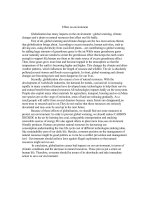


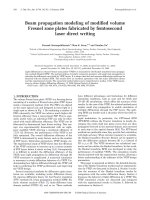
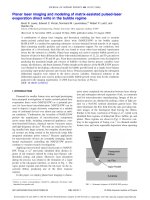

![economic modeling of water[electronic resource] the australian cge experience](https://media.store123doc.com/images/document/14/y/kr/medium_krl1401382233.jpg)

